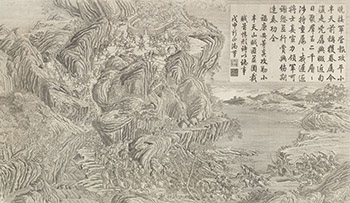

Lot 8021
AN ENGRAVING ILLUSTRATING THE CAMPAIGN AGAINST TAIWAN: ATTACK ON THE MOUNTAIN XIAOBANTIAN Qing Dynasty, Qianlong Period (1736-1795)
The engraving commemorates Emperor Qianlong's military campaign in Formosa from 1786 to 1788. The scene depicts the battle of Xiaobantian. In 1788, famous court painters Yao Wenhan, Yang Dazhang, Jai Quan, Tse Sui, Zhuang Yude, and Li Ming were summoned to create a total of twelve engravings. The twelve Douliumen, Conquer of Douliumen, Conquer of Dali, Attack on the Mountain Xiaobantian, Battle at Kuzhai, Capture of the rebel chief Lin Shuangwen, Battle at Jijipu, Battle at Dawujing, Capture of Zhuang Datian, Crossing the Ocean and the Triumphant Return, and Victory Banquet. The original engravings are now located at the Ziguang Pavilion in the Zhongnanhai. In 1791 and 1792, this series of copperplates was engraved by the Qing Construction Office. The inscription on the top left corner is a poem composed and written by the Qianlong Emperor. The poem states, At dawn, I received a report from the barracks. The report said that the soldiers attacked Mountain Xiaobantian. They captured the family of the thieves a while ago, but they have escaped. The soldiers fought for almost ten days with a total of almost two thousand people. I have told the soldiers many times to be cautious and not to delay the fighting. The leader has worked very hard so I can accept his apologies. I have handed out rewards and punishments according to the soldiers, and I hope that they can be completely successful in their mission next time. Note: Fu Kang-An and others had reported their attack on the thieves at Mountain Xiaobantian to the memorial court. The soldiers surrounded and intercepted the rogue leader. Emperor Qianlong decided to write a poem recording this event in 1788.
At the time, copperplate engraving was considered a foreign style of painting. Having first appeared in Europe, initially, craftsmen used chisels to carve decorative patterns directly on to metal. Afterwards, gravure art etchings started to emerge. The compositions were even able to integrate the Chinese traditional painting technique of expression, thereby rendering the images even more clear and complete. There were only a few copperplate engravings made in the Qing Dynasty palace. Most of them were awarded to princes and civil and military ministers. They mostly circulated within the palace and few were seen in the outside world.
W: 63 cm
L: 89 cm
Estimate
TWD 324,000-486,000
HKD 80,000-120,000
USD 10,300-15,500
Sold Price
PROVENANCE:
Sotheby's Paris 9 June, 2011, lot294
Fine Chinese Ceramics and Works of Art
Ravenel Spring Auction 2015 Hong Kong
Tuesday, June 2, 2015, 5:00pm
